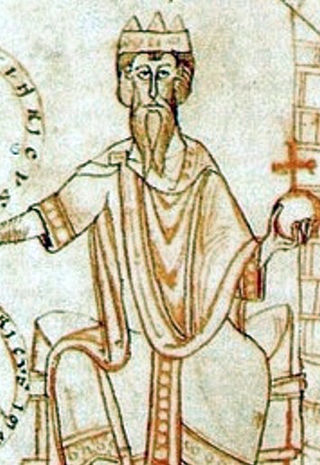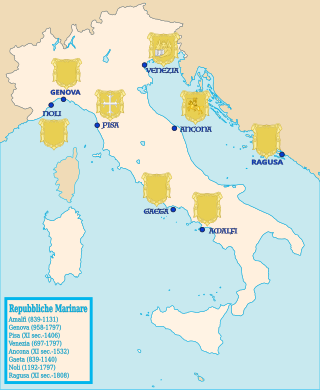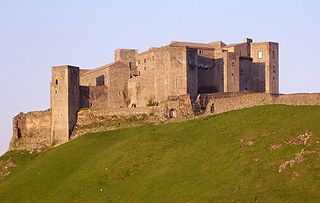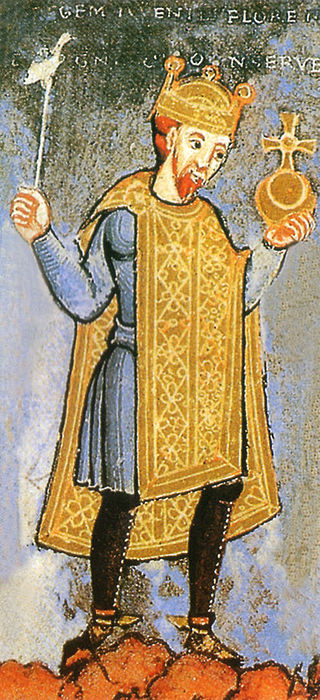
Feudalism, also known as the feudal system, was a combination of legal, economic, military, cultural, and political customs that flourished in medieval Europe from the 9th to 15th centuries. Broadly defined, it was a way of structuring society around relationships derived from the holding of land in exchange for service or labour.

Year 1037 (MXXXVII) was a common year starting on Saturday of the Julian calendar.

Lothair III, sometimes numbered Lothair II and also known as Lothair of Supplinburg, was Holy Roman Emperor from 1133 until his death. He was appointed Duke of Saxony in 1106 and elected King of Germany in 1125 before being crowned emperor in Rome. The son of the Saxon count Gebhard of Supplinburg, his reign was troubled by the constant intriguing of the Hohenstaufens, Duke Frederick II of Swabia and Duke Conrad of Franconia. He died while returning from a successful campaign against the Norman Kingdom of Sicily.

Conrad II, also known as Conrad the Elder and Conrad the Salic, was the emperor of the Holy Roman Empire from 1027 until his death in 1039. The first of a succession of four Salian emperors, who reigned for one century until 1125, Conrad ruled the kingdoms of Germany, Italy and Burgundy.

Baron is a rank of nobility or title of honour, often hereditary, in various European countries, either current or historical. The female equivalent is baroness. Typically, the title denotes an aristocrat who ranks higher than a lord or knight, but lower than a viscount or count. Often, barons hold their fief – their lands and income – directly from the monarch. Barons are less often the vassals of other nobles. In many kingdoms, they were entitled to wear a smaller form of a crown called a coronet.

A fief was a central element in medieval contracts based on feudal law. It consisted of a form of property holding or other rights granted by an overlord to a vassal, who held it in fealty or "in fee" in return for a form of feudal allegiance, services or payments. The fees were often lands, land revenue or revenue-producing real property like a watermill, held in feudal land tenure: these are typically known as fiefs or fiefdoms. However, not only land but anything of value could be held in fee, including governmental office, rights of exploitation such as hunting, fishing or felling trees, monopolies in trade, money rents and tax farms. There never existed a standard feudal system, nor did there exist only one type of fief. Over the ages, depending on the region, there was a broad variety of customs using the same basic legal principles in many variations.
A benefice or living is a reward received in exchange for services rendered and as a retainer for future services. The Roman Empire used the Latin term beneficium as a benefit to an individual from the Empire for services rendered. Its use was adopted by the Western Church in the Carolingian era as a benefit bestowed by the crown or church officials. A benefice specifically from a church is called a precaria, such as a stipend, and one from a monarch or nobleman is usually called a fief. A benefice is distinct from an allod, in that an allod is property owned outright, not bestowed by a higher authority.

The history of Italy in the Middle Ages can be roughly defined as the time between the collapse of the Western Roman Empire and the Italian Renaissance. Late antiquity in Italy lingered on into the 7th century under the Ostrogothic Kingdom and the Byzantine Empire under the Justinian dynasty, the Byzantine Papacy until the mid 8th century. The "Middle Ages" proper begin as the Byzantine Empire was weakening under the pressure of the Muslim conquests, and most of the Exarchate of Ravenna finally fell under Lombard rule in 751. From this period, former states that were part of the Exarchate and were not conquered by the Lombard Kingdom, such as the Duchy of Naples, became de facto independent states, having less and less interference from the Eastern Roman Empire.
Arduin was an Italian nobleman who was king of Italy from 1002 until 1014.
High, middle and low justices are notions dating from Western feudalism to indicate descending degrees of judicial power to administer justice by the maximal punishment the holders could inflict upon their subjects and other dependents. The scale of punishment generally matched the scale of spectacle, so that in France, Paul Friedland argues: "The degree of spectacle [was] originally the basis for a distinction between high and low justice", with an intervening level of 'middle justice', characterised by limited or modest spectatorship, added around the end of the fourteenth century.
The ministeriales were a class of people raised up from serfdom and placed in positions of power and responsibility in the High Middle Ages in the Holy Roman Empire.

Aribert was the archbishop of Milan from 1018, a quarrelsome warrior-bishop in an age in which such figures were not uncommon.
Conrad II, called the Younger, a member of the Salian dynasty, was the duke of Carinthia and margrave of Verona from 1035 until his death.

The Constitutions of Melfi, or Liber Augustalis, were a new legal code for the Kingdom of Sicily promulgated on 1 September 1231 by Emperor Frederick II. It was given at Melfi, the town from which Frederick's Norman ancestors had first set out to conquer the Mezzogiorno two centuries earlier. Originally a reform of the Assizes of Capua of 1220, themselves his reform of the Assizes of Ariano of 1140, the Constitutions formed the basis of Sicilian law for the next six centuries.

The Kingdom of Italy, also called Imperial Italy, was one of the constituent kingdoms of the Holy Roman Empire, along with the kingdoms of Germany, Bohemia, and Burgundy. It originally comprised large parts of northern and central Italy. Its original capital was Pavia until the 11th century.
The Constitutio Romana was drawn up between King Lothair I of Italy (818–855), co-emperor with his father, Louis the Pious, since 817, and Pope Eugene II (824–827) and confirmed on 11 November 824. At the time the election of Eugene was being challenged by Zinzinnus, the candidate of the Roman populace. Eugene agreed to several concessions to imperial power in central Italy in return for receiving the military and juridical support of Lothair. The Constitutio was divided into nine articles. It introduced the earliest known Papal Oath, which the Pope-elect was to give to an imperial legate before receiving consecration. It also restored the custom established by Pope Stephen III in 769 whereby both the laity and clergy of Rome would participate in Papal elections.

Feudal aid is the legal term for one of the financial duties required of a feudal tenant or vassal to his lord. Variations on the feudal aid were collected in England, France, Germany and Italy during the Middle Ages, although the exact circumstances varied.

Henry III, called the Black or the Pious, was Holy Roman Emperor from 1046 until his death in 1056. A member of the Salian dynasty, he was the eldest son of Conrad II and Gisela of Swabia.

Henry II, also known as Saint Henry, Obl. S. B., was Holy Roman Emperor from 1014. He died without an heir in 1024, and was the last ruler of the Ottonian line. As Duke of Bavaria, appointed in 995, Henry became King of the Romans following the sudden death of his second cousin, Emperor Otto III in 1002, was made King of Italy in 1004, and crowned emperor by Pope Benedict VIII in 1014.
Feudalism in the Holy Roman Empire was a politico-economic system of relationships between liege lords and enfeoffed vassals that formed the basis of the social structure within the Holy Roman Empire during the High Middle Ages. In Germany the system is variously referred to Lehnswesen, Feudalwesen or Benefizialwesen.